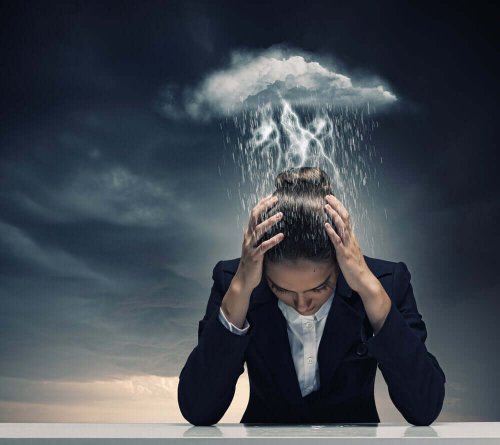Migraine Causes, Symptoms, Diagnosis, and Treatment

A large percentage of people suffer from migraines regularly. This neurological disorder affects their quality of life. As a result, their mood may suffer and this may lead to depression and isolation.
In this article, discover the causes of migraine headaches, as well as their diagnosis and treatment.
What’s a Migraine?
A migraine is a neurological disorder characterized by severe headaches. Overall, many people attribute their pain to stress, tension, or anxiety when, in fact, their experiencing migraines.

A migraine occurs with localized pain on one or both sides of the head. Typically, it’s a pain that completely incapacitates the sufferer and affects a large part of the population (18% of adult women and 6% of adult men).
Classic migraines, also known as “aura” migraines, often begin with vision symptoms. Sensory disturbances such as flashes of light or blind spots manifest. These symptoms usually last between 10 to 30 minutes.
Read: How to Fight Migraines Naturally with 5 Delicious Smoothies
Causes of Migraine Headaches
Overall, people who suffer from migraines tend to experience different patterns and forms of pain. Besides, the patient may even suffer from different forms of migraine-related pain throughout their lives.
Thus, it’s very important to know what can lead to this disorder. After all, this may allow you to prevent or even reduce its intensity. The causes or triggers of this neurological disorder are:
- Smoking and alcohol intake
- Stress
- Sleep disorders
- Exposure to strong odors
- Abrupt climate changes
- Consumption of some foods (MSG, artificial sweeteners, soy, dairy products, caffeine, chocolate, citrus fruits, bananas, avocado, etc.)
- Overexposure to bright lights
- Certain medications
Symptoms of Migraine Headaches
The main symptom is a headache with intense pain that spreads through the head, neck, and facial muscles. This pain can last from 4 to 72 hours. Otherwise, the rest of the symptomatology of this pathology is very characteristic and recognizable:
- The main symptom is an intense headache that extends from the head, neck, and facial muscles. This pain may last from 4 to 72 hours.
- Nausea and vomiting.
- Photophobia and phonophobia. Migraines cause hypersensitivity to light and sound.
- Paleness of the skin.
- Fatigue.
- Palpitations.
- Visual symptoms. Flashes, blind spots, zigzag lines, partial loss of vision, or eye pain may occur.
- Psychological changes. Overall, stress, anxiety, insomnia, depression, and even nervousness and aggression may occur.
Thus, migraine doesn’t allow the sufferer to carry out any activity. In addition, here are other less common symptoms that may also manifest:
- Dizziness.
- Itchiness, tingling, and tickling.
- Involuntary body movements.
- Slurred speech.
Diagnosis
Overall, the diagnosis depends on the patient’s symptoms. To diagnose a patient, the doctor needs a very detailed medical history. Naturally, the information the patient provides about their pain is very important.
Typically, most patients don’t need to see a neurologist to diagnose this condition. Only in cases where a secondary headache or another pathology is suspected will imaging tests may be requested. If this is the case, the typical tests performed are MRI and CAT scan.
In addition, you should also read: A New Development to Treat Migraines
Migraine Treatment

Overall, there are two treatment strategies to fight this condition: Pharmacological treatment and natural therapies.
Pharmacological Treatment
The choice of drug depends on the cause of the migraine:
- Pain killers and anti-inflammatory drugs such as ibuprofen, aspirin, paracetamol, etc. However, these drugs only prove effective on mild or moderate migraines.
- Antiemetics. Typically, these are used to inhibit vomiting and nausea.
- Antihypertensive drugs. In general, these are used for migraines caused by hypertension.
- Antidepressants. Naturally, these are best for migraines and headaches caused by depression or tension.
Natural Therapies
Natural therapies to treat migraine are always based, first of all, on hydration and nutrition. It’s essential to maintain adequate hydration and at the same time, increase the consumption of fresh and natural foods, and eliminate from the diet of ultra-processed products (pastries, snacks, precooked foods, etc.). It’s also important to rule out possible food intolerances, such as gluten or lactose.
This type of therapy takes into account general health in order to treat any disorder. The hormonal system, the functioning of the liver, kidneys, and intestine, our emotions, etc. Very positive results can be achieved with techniques such as acupuncture, homeopathy, magnet therapy, chromotherapy, etc.
All cited sources were thoroughly reviewed by our team to ensure their quality, reliability, currency, and validity. The bibliography of this article was considered reliable and of academic or scientific accuracy.
-
Carod-Artal, F. J., Irimia, P., & Ezpeleta, D. (2012). Migraña crónica: definición, epidemiología, factores de riesgo y tratamiento. Rev Neurol, 54(1), 629-37.
-
Pascual, J. (2001). Migraña: diagnóstico y tratamiento. Medicina clínica, 116(14), 550-555.
-
Pedra, M. P. (1992). Influencia del estrés en el padecimiento de la migraña. Anuario de psicología/The UB Journal of psychology, (54), 97-108.
This text is provided for informational purposes only and does not replace consultation with a professional. If in doubt, consult your specialist.








